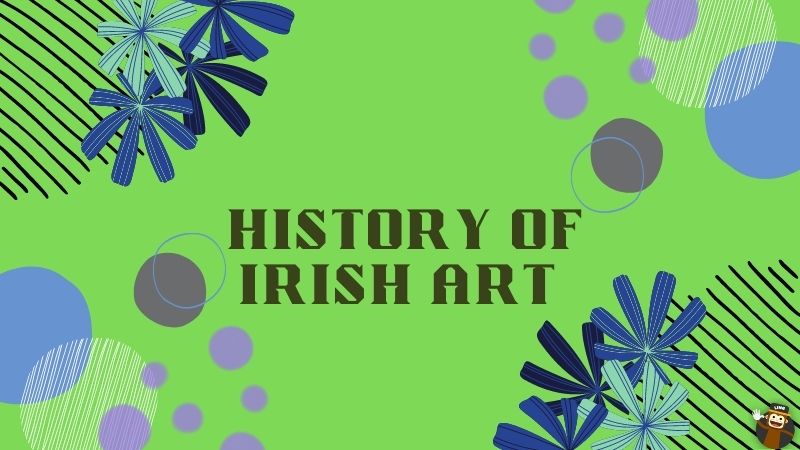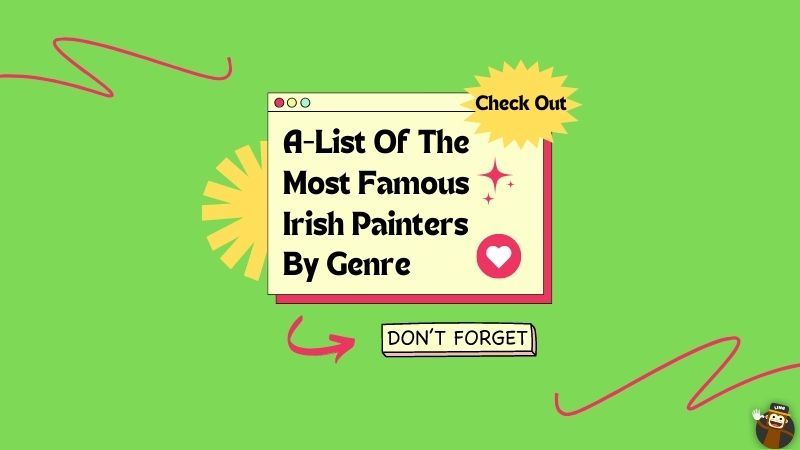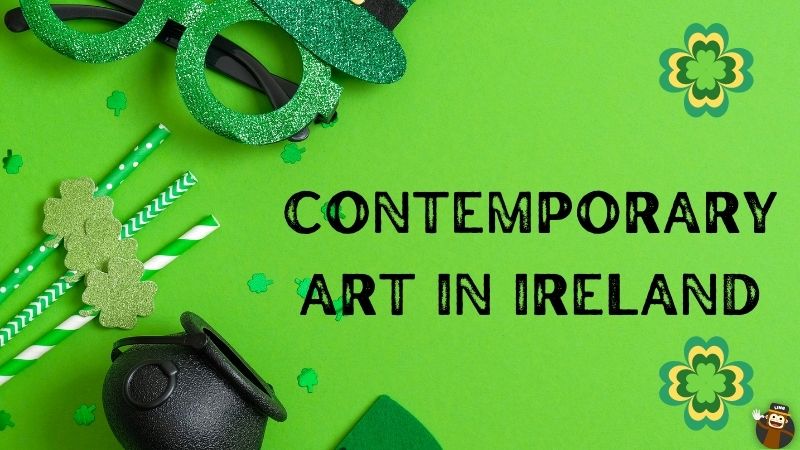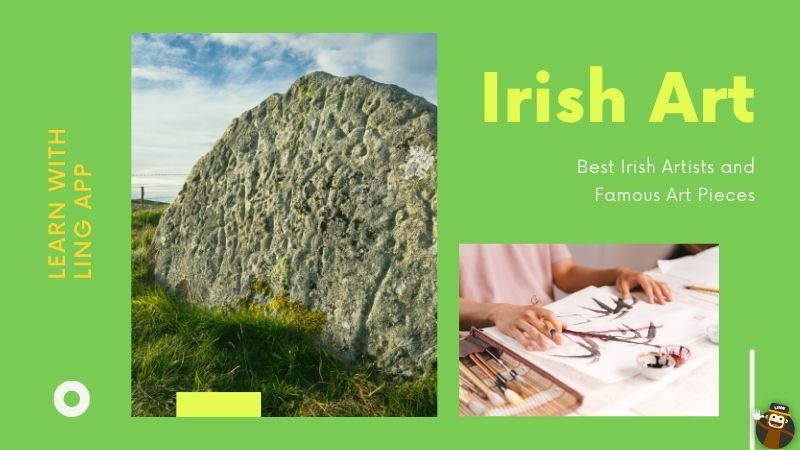Not knowing about Irish art is like not knowing the Irish language. It is like forgetting your roots and traditions. Understanding the country’s art will certainly help you appreciate the language better and get to know the characteristics of the locals. That’s why in this blog post, we are going to share some useful information about Irish Art, so let’s get started!
Irish Art
Allow me to walk you through my experience with Irish art. Basically, I am Irish, born and raised in Ireland. We are a family who takes real pride in being Irish. My mother celebrates all the Irish festivals, while my father could die for the homeland. Being raised by such Irish-proud parents, I always had the patriot in me, but I never realized it until I opened an art gallery.
Now, please do note that I am not an artist. I have probably never held a brush since I was a child in art class. Opening the gallery for me was nothing but a way to make money.
I wasn’t particularly interested in art, although I did find it oddly fascinating how different strokes of brushes could deliver a thousand emotions while being silent.
A year after opening the art gallery, I realized I wasn’t paying attention to Irish art. I figured it is so sad that people often rush to visit my gallery to appreciate art but I, the owner, was never interested in it.
All I wanted was to make a pretty penny. Then, I started researching more about the art of my people, the Irish. Now I understand art far better than before. It has added value to my business and happiness in my life. It’s incredible how Irish artists painted these masterpieces and how different Irish proverbs could be written so beautifully.
History Of Irish Art

The beginning of Ireland’s artistic history may be found in Newgrange, a pre-Stonehenge megalithic tomb in County Meath representing early Irish art. Some academics contend that the elaborate spiral carvings on the megalithic tomb represent the first-ever lunar map.
An additional megalithic building at Knowth is an excellent example of ceremonial and funerary construction from the late Stone Age. One other Neolithic building is the “long barrow.”
Bronze Age
Now after the stone age came the bronze age. In the bronze age, Wedge graves and artifacts from the Beaker culture were made by the Irish. Its drinking containers’ form is the reason for their given name.
During this time, the Irish developed their metalworking skills and learned to forge gold, copper, and bronze. Irish artifacts from the bronze age made by Irish artists are still considered one of the most well-crafted pieces in the whole world in the present day.
The Bronze age was the period during which Irish art developed the most. It was primarily fictional and contained different designs. Irish added these designs to their weapons, utensils, and ale cups. It was during this time that they invented a horn-shaped trumpet.
Iron Age
Ireland’s metalworking by Irish artists was inspired by the Celts during the Iron Age when iron was added as a new material for manufacturing weapons and tools. The La Tene Celtic style, distinguished by its spirals, interlace patterns, and crosses, was the primary focus of Celtic influences.
Celtic art flourished undamaged and survived the Roman era and the Dark Ages without any degeneration since Ireland was never a territory of Rome. Some Irish artists emigrated to Rome.
Swords, spearheads, and spearbutts are examples of weapons crafted during the iron age. The bones of those murdered as part of a sacrifice ceremony during the Iron Age can also be found among the mummified dead, sometimes called bog bodies.
With effort and expertise, skill in metallurgy, stone cutting, and wood carving was developed. Excellent secular art for individual clientele as well as sacred objects for Christian churches and monasteries were produced by Irish metalworkers—the best around the world.
Christian Art In Ireland
Ireland’s isolated location played a factor in St. Patrick’s decision to visit. Barbarians were encroaching on the rest of Europe, and the Dark Ages prevented Christianity’s spread. Church leaders believed that Ireland might serve as a refuge for converts to return from. As Ireland grew more Christianized, several monasteries arose, bringing superior-quality manuscripts. Christianity also influenced Irish artists.
Biblical art and other highly ornamented religious literature were lavishly painted in gold, blue, and purple hues as well as other luxurious pigments of the time, such as those made of gold and silver. It still holds great value in the present day.
Art Locations In Ireland
Ireland is fortunate to have a wide variety of venues for visual art, including important museums devoted to the history of Irish art representing different Irish artists, fine art libraries, small-scale museums, municipal art collections, as well as numerous exciting private art galleries that focus on both traditional Irish art and contemporary paintings by up-and-coming artists from around the world.
The bulk of the pieces on the show may not be as large as those seen in the Uffizi in Florence, the Hermitage in St. Petersburg, the Musee d’Orsay, or the Louvre, but they do include Old Masterpieces by artists like Velazquez and Goya. The audience loves an old piece with a story.
A-List Of The Most Famous Irish Painters By Genre

Now, for your ease, we present you with a list of the most famous Irish painters by genre.
Best Narrative Painter
Do you know about the Best Irish Narrative Painter spreading different colors? Let’s find out together.
Conor Walton
He was born Irish and a realist when it came to art, and his sculptures are nothing short of amazing. His art is full of expression and emotions.
The portrait of Reverend Ian Paisley is one of his most famous pieces. It was sold at competitive prices.
Best Portrait Painters
David Nolan
Nolan’s art was subtle yet expressive. His portraits told a silent story. He is one of the most well-known Irish artists. His prints are purchased at high prices.
Conor Walton
Conor’s art was realistic. He expressed the portraits in their true essence. It was like living art. His paintings are also purchased in America.
Best Genre-Painter
Collin Davidson
Colin Davidson is one of the Best Genre-Painters of all time in Ireland. Davidson painted the scenes like they were from a novel. You could imagine sitting in the scene as it felt like it was real. Maybe it was because he started painting at an early age.
Best Expressionist Landscape Painter
Here are the two top Best Expressionist Landscape Painters who started art as a hobby.
Paul Henry
Paul, born Irish, was an exceptional landscape painter who painted a scene like no one else.
Donald Teskey
His scenes were full of color, passion, imagination, and creativity. He was considered a modern artist because of his style. His art is more from Northern Ireland.
Best Impressionist Landscape Painter
Paul Kelly
Paul Kelly is the Best Impressionist Landscape Painter. Paul Kelly’s painting seemed like he painted the past from his thoughts. He was a painter whose paintings screamed nostalgia, and the themes were brownish. His paintings were color and emotion on the canvas.
Abstract Art
Sean Scully
Sean Scully is the best Irish painter considering abstract art. When I visited the Scully abstract, I could feel the emotions he would have had while painting the shapes in his artwork. He was a master of shapes and forms on canvas.
Best Painter Of Reflected Light On Water
John Morris
John Morris is the Best Painter of Reflected Light on Water. John captured sunset in a way that I had never seen before. One feels the sun’s warmth and the cold dawn breeze while staring at his paintings. He paints Northern Ireland well. He painted with oil paint.
Best Still Life Painters
Here are the two Best Still Life Painters in Ireland.
Mark O’Neill
Mark was born Irish, a master of drawing portraits. He portrayed emotions in a way that I had never seen before. His paintings spoke a language with no words, like living art on canvas.
James English
He was born Irish and was famous for his oil paintings of people. His portraits were like life instilled in oil on canvas. It’s like music without sound.
Contemporary Art In Ireland

Ireland’s most well-known living artists include James Coleman, an installation and video artist, and Dorothy Cross, a sculptor. Brian O’Doherty, a conceptual artist, and abstract painter Sean Scully, all of whom are located in New York City.
Sean Hillen, Willie Doherty, and Robert Ballagh are all active in contemporary media. In the 1970s and the beginning of the 1980s, the Irish Independent Artists had exhibitions in the David Hendrik’s Gallery in Dublin. One of its founding members was Joe O’Connor, a figurative and lively painter of well-known sports figures.
With the country’s economic growth, interest in collecting Irish art has swiftly increased, particularly concentrating on investments in early 20th-century painters. Young Irish artists still receive less support than their European peers because of fewer venues and infrastructure. Considering this in mind, the Arts Council has concentrated on enhancing venue professionalism and infrastructure for the betterment of their art. Efforts are being made for it in the present.
Is Learning About Irish Art Important?
Learning about Irish art is important for anyone part of Ireland or for artists in general. Irish as a community have a rich history, and the art is vast in every form, from sculptures to sketches to oil paintings.
Not only that, there are some priceless pieces for the collectors out there for the audience. Ireland is a country that has been through a lot of ups and downs, and its art visualizes that fantastically. It tells a story of how the Irish came into being, worked on themselves, and proved to be one of the greatest nations ever to exist.
Wrapping Up

Saying that, you might ask, “where do we learn about Irish art from?” If you are ever in Ireland, we highly recommend checking out the local and national art galleries, as there is nothing like appreciating live art and the work done by Irish artists. If you want to learn the Irish language, then don’t worry. Ling has its own app and website to help you with the Irish language’s history and pictures of the famous pieces. Gain new Irish vocabulary in no time! Also, check out Irish Cooking Utensils Vocabulary and Common Irish Vocab In Daily Life to improve your vocabulary.
Sign up today and download the Ling App so we can work on your Irish together. Start learning Irish now!
Happy Learning!





















